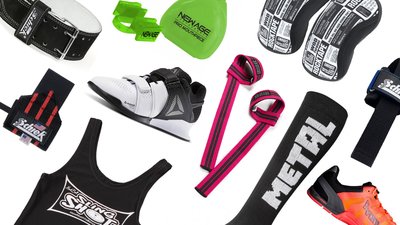Powerlifting for Beginners | Nutrition for Powerlifters | Powerlifting vs. Bodybuilding | Powerlifting Training for Women | Powerlifting Meet Prep | Advanced Powerlifter Pro Tips | Essential Powerlifting Gear
Unlike yachting or polo, powerlifting doesn't cost a fortune to undertake. You can train the main lifts of the squat, bench, and deadlift at pretty much any commercial gym, or even in your garage. All you need is a bar, some plates, a squat rack and bench press station—maybe a spotter every once in a while—and you're good to go.
Or at least, that's how it is at first! As you grow more accomplished at powerlifting, your needs can change. If you're following a demanding program like Uplifted: Build Muscle and Strength with Meg Squats, or if you're thinking about competing, then it's time to invest in your success.
Here are a few basic tools you'll find immensely beneficial when you're dancing with a heavy barbell.
1. Lifting Shoes
Every lifter is different, and so are their shoe needs. But in powerlifting, there are pretty much two camps: high-bar squatter who benefit from a high-heeled shoe, and low-bar squatters who squat in flats or Converse All-Stars.
How do you know which you are? If you struggle to hit competition-grade depth on your squats, then it's quite likely that an elevated heel would help you. Squat shoes provide stabilization, support, comfort, angle, and drive. Their flat sole enables you to sit back farther into a squat and is especially good for lifters whose hip mobility isn't, shall we say, world-class. Olympic weight-lifting shoes lock your feet into the ground and create an extremely strong base from which to lift.
Our Pick: The Reebok Legacy Lifter II and PR II are a solid balance of high enough and stable enough. But whatever shoe you choose, make sure it has a solid—not squishy—sole. You need stability when powerlifting. You'll probably need to try several different kinds of shoes before finding the one that's just right for you.
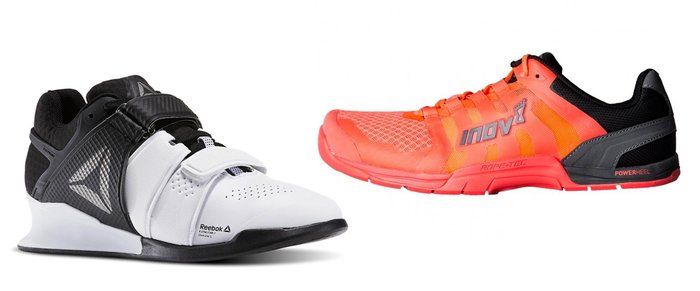
2. Lifting Belt
The purpose of a lifting belt is to stabilize the torso, help you brace your core, and to keep you upright during your heaviest lifts. A weightlifting belt can also help hold in your breath to help you generate pressure in your core and protect your lower back. As researcher and powerlifter Greg Nuckols explains in The Ultimate Weightlifting Belt Guide, there's really no doubt that the right belt can help you move more weight, more safely.
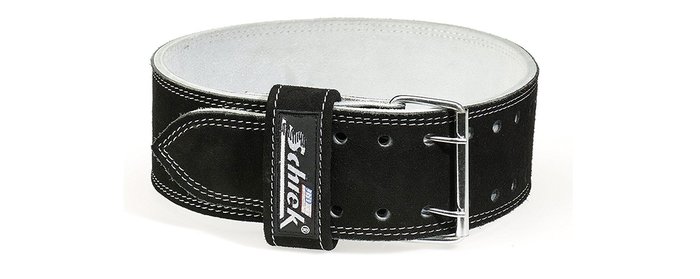
The most important consideration when choosing a lifting belt is whether it fits you well. The belts, which are usually made of leather, suede, or nylon, come in two different types: lever belts and prong belts. Each style has its pros and cons, and the choice often comes down to which one feels best when you're lifting.
Women with very short torsos may find that the tapered style of prong belt works well. In Uplifted's heavy squat workouts, for example, Meg Squats uses a thick leather prong belt. If you're in doubt, it's better to buy a little small than a little large.
Our Pick: RDX Sports and Schiek both make a range of belts that are suitable for starting powerlifters, but that can grow with you as you get stronger.
3.Wrist Wraps
Wrist wraps are a great way to keep wrist and hand pain from limiting your bench press. should be at least 12 inches long, though most competitive powerlifters prefer 24-30-inch wraps. The longer they are, the more there is to wrap around the wrist joints for a tighter compression, thus providing more support.
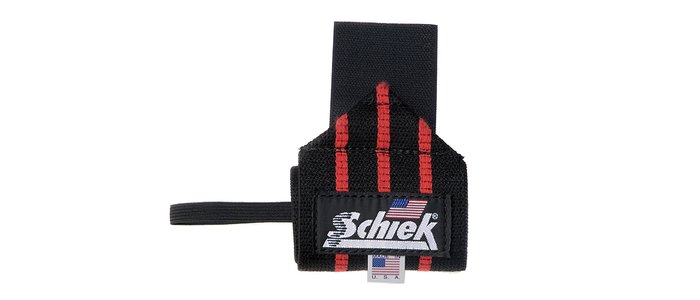
Our Pick: Wraps don't need to be fancy to be effective. Schiek and Bear Komplex both make solid, inexpensive wrist wraps. If you're getting really serious, SBD makes more expensive wraps favored by many world-class lifters.
4. Lifting Straps
Lifting straps help you hold onto the bar or dumbbell when you're using very heavy weights, eliminating grip strength as the limiting factor during an exercise. You can't use them in competition, but straps can be especially useful when you're doing heavy back-focused assistance work or double-overhand deadlifts.
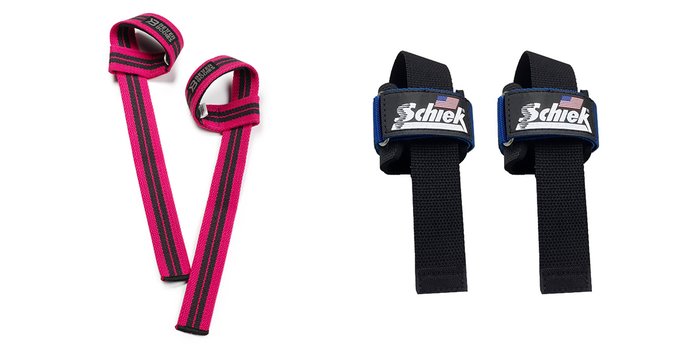
Powerlifting coaches will tell you that you don't want to get addicted to straps. You still need a strong grip, after all! But many women find they're essential for building back strength without relying on momentum or over-taxing the grip and forearms.
Our Pick: Basic leather or nylon straps can last you a long time. No need to go fancy here!
5. Chalk
Chalk dries moisture on your hands and creates friction between your skin and the weight so you don't lose hold of the bar. The chalk also protects callouses from ripping and prevents blisters on your hands. The last thing you want to do is to pull heavy weights with torn and bleeding hands. I use chalk whenever I train heavy deadlifts and farmer's walks.

The chalk itself won't necessarily prevent callouses—it may even help them grow—so it's important to take good care of your hands. Having big callouses isn't exactly something to brag about, as you'll discover the first time one rips off and you can't grab the bar for a week. Keep your calluses small by filing them down as often as necessary.
Our Pick: If your town has a rock climbing gym, buying whatever the climbers use can be good enough! The online company VIKN also makes great chalk that many elite lifters use.
6. Mouth Guard
The American Dental Association recommends the use of a mouthguard for 29 different sports, including weightlifting! Mouth guards protect your teeth from the grinding and gritting that come with intense training. Competitors at the World's Strongest Man and other elite events wear them more often than not anymore.
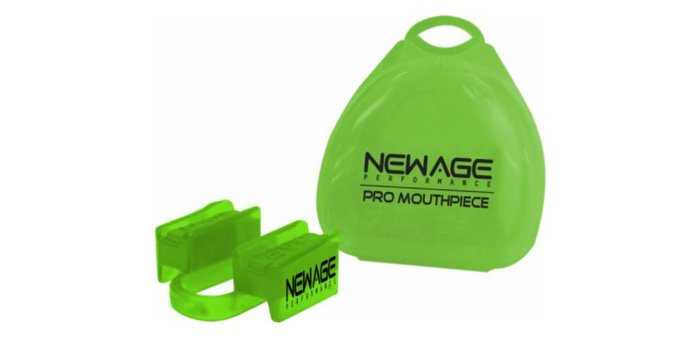
They also provide something for your teeth to bear down on during heavy pulling, pushing, and squatting. I consider my mouth guard one of the most important pieces of my lifting gear. I find it actually makes an enormous difference in my heavy powerlifts.
Our Pick: New Age Performance mouthpieces are considered some of the best-made in the world right now. You might be surprised at the range of athletes that use them!
7. Knee Sleeves
Don't confuse these with knee wraps! Those are for seriously advanced powerlifters only. Knee sleeves are a lighter alternative keep your ligaments warm, protect your knee joints when squatting heavy, and help with the rebound out of the hole on the bottom of a squat.
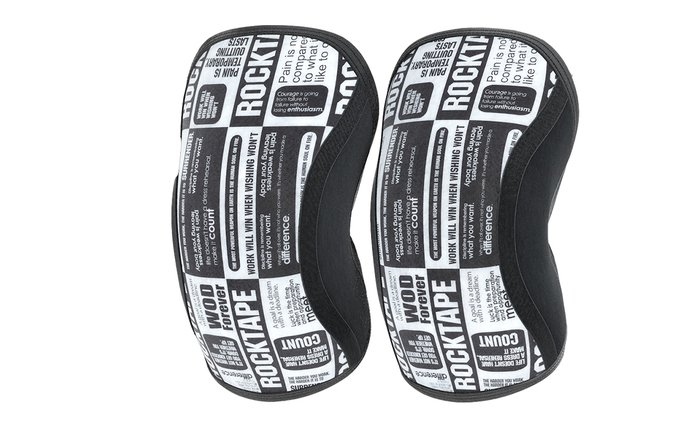
Our Pick: Many companies including Mark Bell's Sling Shot, Bear Komplex, RockTape, and others make quality knee sleeves. Trust me: You'll appreciate these as the squats get heavier!
8. Deadlift Socks
Many lifters wear long socks when performing conventional deadlifts on conventional-style deadlifts to prevent scraping and bruising of their shins. Are they essential? Not really. Can they help protect you from getting bloody? Sure. Do you think bloody shins look cool? That's for you to decide.
Our Pick: For most people, one long pair of socks will be as good as another. If you want to announce to the rest of the ladies in your weight class that you're here for serious business, SBD's deadlift socks fit the bill.
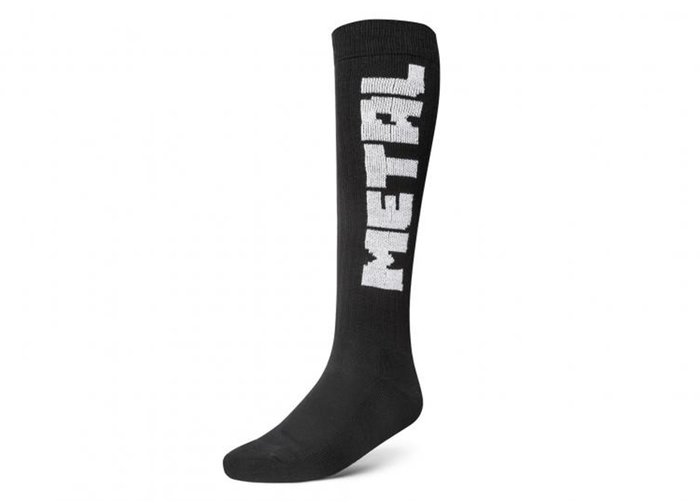
9. Powerlifting Singlet
If you're going to compete, you'll need a singlet. No way around it! Not only do they provide comfort and flexibility as you lift, but they also resist the tearing that can come from moving large weights against your body. Be sure that the singlet you choose meets the standards of the sport. Unlike benching shirts, the singlet should provide no additional support as you lift.
Our Pick: Mark Bell's Sling Shot makes a range of well-made, budget-minded singlets. Inzer Advanced Designs' classic lifting singlet is always a good choice as well. A newer company, Virus, also makes quality singlets with a woman's physique in mind.
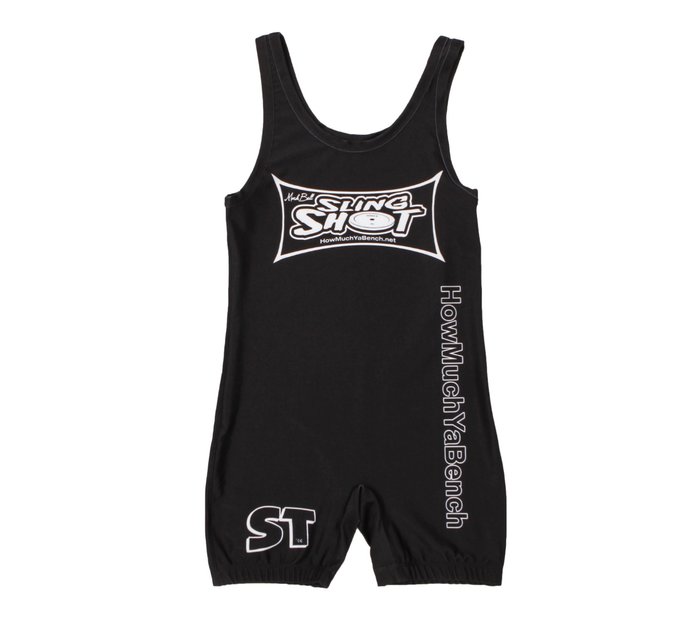
Know Your Rules!
The organizations that sponsor powerlifting competitions are called "federations," and every one of them has its own unique set of rules and regulations about the gear they allow. Some federations are very particular and dictate even the brands of knee sleeves, belts, wrist wraps, and other gear they allow lifters to use.
If you see competitive powerlifting in your future, make sure you know what events you plan on competing in and what gear—and brands of gear—are allowed at each one. Don't spend hundreds of dollars on gear, train with it, and then show up to a meet just to find out you can't use any of it.

